|
|

By Jo Nova
Proving that unpaid anonymous review is worth every cent, the 217 year old Wiley science publisher “peer reviewed” 11,300 papers that were fake, and didn’t even notice. It’s not just a scam, it’s an industry. Naked “gobbledygook sandwiches” got past peer review, and the expert reviewers didn’t so much as blink.
Big Government and Big Money has captured science and strangled it. The more money they pour in, the worse it gets. John Wiley and Sons is a US $2 billion dollar machine, but they got used by criminal gangs to launder fake “science” as something real.
Things are so bad, fake scientists pay professional cheating services who use AI to create papers and torture the words so they look “original”. Thus a paper on ‘breast cancer’ becomes a discovery about “bosom peril” and a ‘naïve Bayes’ classifier became a ‘gullible Bayes’. An ant colony was labeled an ‘underground creepy crawly state’.
And what do we make of the flag to clamor ratio? Well, old fashioned scientists might call it ‘signal to noise’. The nonsense never ends.
A ‘random forest’ is not always the same thing as an ‘irregular backwoods’ or an ‘arbitrary timberland’ — especially if you’re writing a paper on machine learning and decision trees.
The most shocking thing is that no human brain even ran a late-night Friday-eye over the words before they passed the hallowed peer review and entered the sacred halls of scientific literature. Even a wine-soaked third year undergrad on work experience would surely have raised an eyebrow when local average energy became “territorial normal vitality”. And when a random value became an ‘irregular esteem’. Let me just generate some irregular esteem for you in Python?
If there was such a thing as scientific stand-up comedy, we could get plenty of material, not by asking ChatGPT to be funny, but by asking it to cheat. Where else could you talk about a mean square mistake?
Wiley — a mega publisher of science articles has admitted that 19 journals are so worthless, thanks to potential fraud, that they have to close them down. And the industry is now developing AI tools to catch the AI fakes (makes you feel all warm inside?)
EMIL LENDOF THE WALL STREET JOURNAL
By Nidhi Subbaraman, May 14, 2024
Fake studies have flooded the publishers of top scientific journals, leading to thousands of retractions and millions of dollars in lost revenue. The biggest hit has come to Wiley, a 217-year-old publisher based in Hoboken, N.J., which Tuesday will announce that it is closing 19 journals, some of which were infected by large-scale research fraud.
In the past two years, Wiley has retracted more than 11,300 papers that appeared compromised, according to a spokesperson, and closed four journals. It isn’t alone: At least two other publishers have retracted hundreds of suspect papers each. Several others have pulled smaller clusters of bad papers.
Although this large-scale fraud represents a small percentage of submissions to journals, it threatens the legitimacy of the nearly $30 billion academic publishing industry and the credibility of science as a whole.
Scientific papers typically include citations that acknowledge work that informed the research, but the suspect papers included lists of irrelevant references. Multiple papers included technical-sounding passages inserted midway through, what Bishop called an “AI gobbledygook sandwich.” Nearly identical contact emails in one cluster of studies were all registered to a university in China where few if any of the authors were based. It appeared that all came from the same source.
One of those tools, the “Problematic Paper Screener,” run by Guillaume Cabanac, a computer-science researcher who studies scholarly publishing at the Université Toulouse III-Paul Sabatier in France, scans the breadth of the published literature, some 130 million papers, looking for a range of red flags including “tortured phrases.”
Cabanac and his colleagues realized that researchers who wanted to avoid plagiarism detectors had swapped out key scientific terms for synonyms from automatic text generators, leading to comically misfit phrases. “Breast cancer” became “bosom peril”; “fluid dynamics” became “gooey stream”; “artificial intelligence” became “counterfeit consciousness.” The tool is publicly available.
Generative AI has just handed them a winning lottery ticket,” Eggleton of IOP Publishing said. “They can do it really cheap, at scale, and the detection methods are not where we need them to be. I can only see that challenge increasing.”
The ABC in Australia even wrote about this, but only because it worries about the loss of public faith in its pet universities:
For the ABC, peer review is like the Bible, and universities are the Church. The public must believe!
So the ABC makes excuses… Oh! Those poor poor universities, forced to become billion dollar businesses selling defacto Australian-citizenships to children of rich Chinese families. If only they got more money, their Vice Chancellors wouldn’t have to make do with million dollar salaries, and punishing professors who pointed out fraud, and they’d have time to do research and prevent the fraud instead.
Wiley’s ‘fake science’ scandal is just the latest chapter in a broader crisis of trust universities must address
By Linton Besser, ABC News
 It [the Wiley debacle] also illustrates what is just another front in a much broader crisis of trust confronting universities and scientific institutions worldwide. It [the Wiley debacle] also illustrates what is just another front in a much broader crisis of trust confronting universities and scientific institutions worldwide.
For decades now, teaching standards and academic integrity have been under siege at universities which, bereft of public funding, have turned to the very lucrative business of selling degrees to international students.
Grappling with pupils whose English is inadequate, tertiary institutions have become accustomed to routine cheating and plagiarism scandals. Another fraud perfected by the internet age.
This infection — the commodification of scholarship, the industrialisation of cheating — has now spread to the heart of scientific, higher research.
With careers defined by the lustre of their peer-reviewed titles, researchers the world over are under enormous pressure to publish.
Suffer the researchers who are forced to pay for fake papers just so they can “do their job”? Sack the lot.
The ABC is part of the reason science is corrupt to the core. The ABC Science Unit is paid to hold junk-science’s feet to the fire, instead it provides cover for the pagan witchcraft that passes for modern research.
The rot at Wiley started decades ago, but it got caught when it spent US $298 million on an Egyptian publishing house called Hindawi. We could say we hope no babies were hurt by fake papers but we know bad science already kills people. What we need are not “peer reviewed” papers but actual live face to face debate. Only when the best of both sides have to answer questions, with the data will we get real science:
In March, it revealed to the NYSE a $US9 million ($13.5 million) plunge in research revenue after being forced to “pause” the publication of so-called “special issue” journals by its Hindawi imprint, which it had acquired in 2021 for US$298 million ($450 million).
Its statement noted the Hindawi program, which comprised some 250 journals, had been “suspended temporarily due to the presence in certain special issues of compromised articles”.
Many of these suspect papers purported to be serious medical studies, including examinations of drug resistance in newborns with pneumonia and the value of MRI scans in the diagnosis of early liver disease. The journals involved included Disease Markers, BioMed Research International and Computational Intelligence and Neuroscience.
The problem is only becoming more urgent. The recent explosion of artificial intelligence raises the stakes even further. A researcher at University College London recently found more than 1 per cent of all scientific articles published last year, some 60,000 papers, were likely written by a computer.
In some sectors, it’s worse. Almost one out of every five computer science papers published in the past four years may not have been written by humans.
Even if one in five computer science papers are written by computers, this is just the tip of the iceberg of the rot at the core of “peer reviewed research”. The real rot is not the minor fraudsters making papers that no one reads to pad out their curriculum vitae. It’s the institutional parasites taking billions from taxpayers to create modeled garbage to justify the theft of trillions. But that’s another story.
PS: Who knew, academic journals were a $30 billion dollar industry?
h/t SharperinOz
9.8 out of 10 based on 138 ratings
9.4 out of 10 based on 12 ratings

Saving the world with silent killers
A new study shows electric cars are twice as likely to hit pedestrians compared to petrol and diesel cars. Presumably this is because EVs are so quiet. Though it’s also possible the dash interfaces are hideous, and some menu options are more deadly and distracting than others. Or perhaps EV drivers are more stressed or feeling nauseous? The study didn’t investigate that.
Amazingly the data was from six to ten years ago in the UK, so countless people have died in the interim, and if it is just a noise issue, it could have been fixed, or at least investigated. Where is the precautionary principle when you need it?
And if electric cars are killing more people in cities, we would presume that Fido and Spot would be a part of the carnage too. But who would know what the car-pet-kill tally was? Well, manufacturers might — they own the camera footage, but no one is even asking that question. Animals have rights you know, but they don’t donate to Greenpeace.
The Greens are rushing headlong to roll out the auto-weather-saving-machines across the countryside, and they might be killing wallabies and spotted quolls too but who cares, right? It’s not like anyone has done that study, or the Greens are worried about flattening a few rare endangered animals on their road to redemption.
Apparently, it makes sense if a few extra people and pets die now to save someone else who might suffer in one hundred years, maybe, if the computer models are right, and if EVs reduce emissions, and if emissions matter in the first place. All of which is unlikely. But rush, sprint, hurry to force those EVs onto the road. Even if they kidnap people, or kill children, it’s all for a good cause.
Scitech Daily
Study reveals a higher risk of accidents in urban areas across Great Britain from 2013 to 2017. Researchers call for measures to mitigate this risk as fossil-fuel vehicles are phased out.
A study has found that pedestrians are twice as likely to be hit by electric or hybrid vehicles compared to those powered by petrol or diesel. The research, which was published on May 21, 2024, in the Journal of Epidemiology & Community Health, examined casualty rates in Great Britain from 2013 to 2017.
The risk is greater in urban areas, and governments must take steps to mitigate this safety hazard as they proceed to phase out fossil-fueled vehicles to improve air quality and curb climate change, urge the researchers.
Road traffic injuries are the leading cause of death for children and young people, and 1 in 4 road traffic deaths are of pedestrians, they note. Amid the ongoing shift to electric and hybrid cars, concerns have been raised that these vehicles may pose more of a safety hazard to pedestrians than fossil-fuelled cars because they are quieter, particularly in urban areas where background ambient noise levels are higher.
the researchers calculate that between 2013 and 2017, the average annual casualty rates of pedestrians per 100 million miles of road travel were 5.16 for electric and hybrid vehicles and 2.40 for petrol and diesel vehicles.
Perhaps it’s really the fault of all those young inexperienced drivers?
And younger, less experienced drivers are more likely to be involved in a road traffic collision and are also more likely to own an electric car, possibly accounting for some of the observed heightened risk associated with these vehicles, they suggest.
Sure. These are the same careless teenagers who were “more likely” to splash $100 K on a Tesla Model S in 2016, right? What are these researchers thinking?
The only thing we know for sure is that the rush to force EVs on us has nothing to do with morality or compassion. It’s not about saving lives or protecting fluffy mammals. The Greens don’t care about those lives now, let alone the people of the future.
______________________
More tales from the EV files:
10 out of 10 based on 86 ratings
9.4 out of 10 based on 14 ratings
By Jo Nova
Games with levelized guesses don’t take all the hidden costs into account
Prize of the day for national policy research goes to Nick Cater, who managed to ridicule our billion dollar national science agency, the CSIRO, with a newspaper column.
The CSIRO put out a report proclaiming that nuclear power would be impossible before 2040 and cost “twice as much” as renewables. But Nick Cater just compared electricity in New South Wales to Finland to prove their 129 pages of modeled costs were wrong:
On Saturday…. Electricity generation in NSW was releasing 750g of carbon into the atmosphere per megawatt hour of electricity. In Finland, it was 35g.
If the CSIRO’s GenCost report is to be believed, Finnish electricity prices should have gone through the roof a year ago when its newest reactor was turned on. They did not. The retail price of electricity in Finland, which is indexed to the spot market, came down almost immediately.
Were Energy Minister Chris Bowen to spend a few days in Finland, he might realise almost everything he says about nuclear is complete and utter nonsense. This might be why he spent his time in Europe last year trying to sell green hydrogen to the Germans.
All over Europe the countries with the most solar and wind power have the highest prices
Modeling electricity costs is ripe for the plucking, so the only costs that count are the real ones that customers pay. According to Eurostat data on electricity prices in the EU last year, some countries were paying twice as much as others. And the cheapest electricity was in countries using coal power or lands with lots of hydroelectricity and plenty of water.
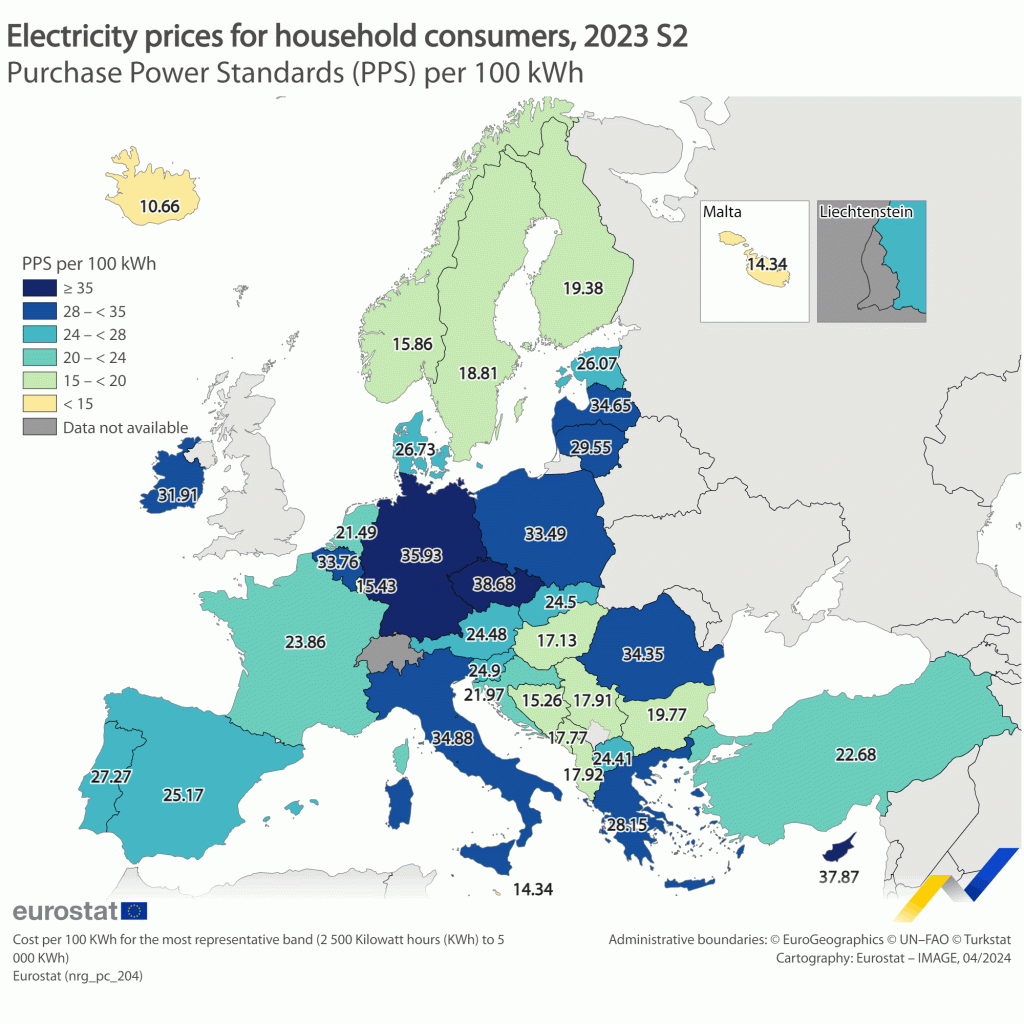
And if nuclear power was “eight times” more expensive than solar and wind, why is that Germany pays so much more for electricity than France does?
Germany, Italy, Poland, and Greece are all pricey but none of them have nuclear plants (yet).
Serbia has cheap electricity and it is nearly 70% coal powered. Norway has cheap electricity and 100,000 natural Fjords for hydroelectricity.
Look who has solar power and expensive electricity:
Things aren’t working out well for Greece, Germany and Italy.
Look who has wind power too
Denmark has a lot of wind, but it also has seven interconnectors to countries with cheap reliable hydro and nuclear power. We don’t.
CSIRO artificially pumped up the cost of building a nuclear plant in Australia because it would be a new industry here. Did they do that for technologies that are barely invented like hydrogen and batteries too? They claim it would take 15 years to build one plant, yet the French built 56 plants in 15 years, and that was 40 years ago. The average build time then, without faxes, flip phones and “the internet” was just 7 years, yet somehow they got it done. Do the CSIRO think they can get away with publishing this kind of incompetent partisan hackery and Australians won’t find out?
9.9 out of 10 based on 108 ratings
8.7 out of 10 based on 15 ratings

By Jo Nova
Six months after Geert Wilders won the Dutch election he has finally negotiated an agreement with a few minor parties to form government and the unthinkable has happened. The centre-of-the-road conservatives (referred to as “far right extremists”) got elected to unwind the worst excesses of the totalitarian left. Henceforth, the forced farm reclamations will stop, mandated heat pumps are out, electric car subsidies are going and in a brave scientific move, no one will be culling livestock to change the weather. The Netherlands won’t have to pursue stronger environmental policies than the rest of the EU so their leaders can show off at cocktail parties and get jobs with the UN. The Netherlands will still be tied to crazy EU rules, but those elections are coming next month. And official government ministers are so much harder to ignore in EU negotiations. The landscape has changed.
The Telegraph in the UK gets the message: The Tories should go to war on Net Zero. This applies everywhere else too. Tony Abbott didn’t win a 90 seat landslide victory in Australia by trying to do half a carbon tax. He won because he said he would Axe the Tax. (And Stop the Boats.)
The political candidate who goes to war on Stupid Plans has the freedom to point out the all the stupidity. The weaker man with a halfway plan is still agreeing with the witchcraft, he’s just suggesting a different spell. No wonder it doesn’t sell.
To arrange the deal Wilders gave up the Prime Ministership (a win no doubt for the namecalling mud slingers), but he appears to be the one in charge nonetheless. We hope he gets his day…
h/t to NetZeroWatch
Dutch farmers force heat pumps about-turn
Meike Eijsberg London and James Crisp, The Telegraph
The Netherlands will tear up rules forcing homeowners to buy heat pumps as part of a war on net zero by Geert Wilders and the Dutch farmers’ party.
Six months after his shock election victory, Mr Wilders this week struck an agreement to usher in a Right-wing coalition government of four parties. “We are writing history,” he said as he announced the programme for the new government.
The new coalition marks the first time that a party focused on the interests of the agricultural sector has got into power in the Netherlands. Earlier this year, mass farmers’ protests swept Europe.
The coalition pact includes pledges to reverse green policies introduced under the previous government to hit EU climate targets, including compulsory buyouts of polluting farms. It also plans to end subsidies for electric cars in 2025 and rejects an EU demand that the Dutch reduce livestock numbers to cut pollution.
The Tories should go to war on net zero excess
Editorial, The Telegraph
But now even Western countries are starting to turn against the worst excesses of the green movement. The new Dutch coalition has released its programme for government, and at the heart of it are a swathe of pro-consumer, pro-energy security policies, reversing some of the bizarre environmental schemes introduced by its predecessors.
Among them was a programme to compulsorily purchase farms to meet EU climate targets. The result was a farmers’ revolt and a new insurgent political party. The coalition agreement tears up rules forcing homeowners to buy heat pumps, and scraps an obligation that the Netherlands should pursue a “more ambitious environment policy” than the rest of Europe.
Young voters are shifting right and breaking “taboos”
Geert Wilders party did better among 18 – 35 year olds than among some older groups. If all ages matched the younger vote his party would have won four more seats.
At Politico writers are worried that trends like this, which are also seen in Portugul and France mean the “taboos against voting for populist anti-immigration parties is fading”. Which begs the question of who decided that was taboo in the first place?
Their biggest fear is that even young voters are breaking out of their educational pens. They paint this as a devious “far right” opportunity, instead of what it really is, the young rebelling against a lifetime of propaganda. The old jargon and namecalling formula to bully the workers into submission isn’t working any more.
Geert Wilders turned all corners of Dutch Society into far right voters
By Hanne Cokelaere and Eva Hartog, Politico
Across Europe, far right parties are advancing with support from young — and first time — voters. Despite being one of the EU’s wealthiest countries, the Netherlands’ shortage of affordable housing has become a key concern. Amid rising prices, many have an increasingly cynical outlook on life. Unlike their parents and grandparents, this generation feels less restricted by party loyalties, making them more of a wild card and therefore an attractive pool of new voters for anti-establishment candidates.
“The older voter, who was still loyal, is dying; younger voters are going in all directions,” said Josse de Voogd, a Dutch researcher who has made electoral geography his specialty.
For far-right parties, that presents an opportunity.
Wilders’ success took many by surprise, but it is indicative of a broader trend: The taboo of voting for populist, anti-immigration parties is fading. In the June EU election, the European Parliament’s Identity and Democracy group is projected to reap the electoral benefits of increasingly broad support; also among young voters.
In Portugal, exit polls from the March election suggested that under-30s accounted for approximately 25 percent of those who voted for the far-right Chega party.
Young voters are looking for a strong leader and few men are as strong as Geert Wilders — the man who received countless death threats and lives under permanent guard, but keeps going.
It is easy to imagine the new Prime Minister (whoever that is) living in the shadow of the real leader, the man who takes risks.
9.9 out of 10 based on 126 ratings
9 out of 10 based on 11 ratings

By Jo Nova
Finally, the Green-left activists are starting to ask if Big Money is distorting their own environmental efforts
Twenty years too late, a few on the green patsy environmental side are starting to feel “uneasy” about the billions of dollars gifted into their accounts by the nice caring bankers and oligarchs. The money thrown at believers is so obscenely big even they are raising eyebrows.
After smearing skeptics as shills for Big Oil, a few on the left are wondering if funds 300 times larger just from one man might be a bit concentrated. The Bezos Earth Fund has $10,000 million dollars in total to give away but in the last three decades of climate debate the evil Exxon only gave skeptics a grand total of $30 million dollars. Now they worry?
They wonder if Jeff Bezos is controlling too much of the environmental charity funding, and that he really wants to set up carbon offset schemes which greens fear will be “greenwashed” corrupted and a waste of time. This is quite a rare hint that a few in the environmental circles are just starting to be suspicious that they are being used to support other money making agendas.
But this is a crack in the door for skeptics to wedge:
By Patrick Greenfield, The Guardian
Launched with a skeleton team in February 2020, the Bezos Earth Fund aims to give away $10bn (£7.9bn) of the Amazon founder’s $200bn personal fortune to combat the climate crisis and biodiversity loss by the end of the decade. So far, it has issued more than 230 grants worth $2bn, funding initiatives from AI environmental solutions to clean energy for disadvantaged communities.
In the process, the Bezos Earth Fund has become one of the most influential voices in the climate and biodiversity sector, with its fellows, advisers and directors a high-profile presence at international negotiations.

Now they worry about the conflict of interest?
But privately in the climate and biodiversity sector, the mood around the Bezos Earth Fund has turned to one of growing unease. Researchers, climate policy advisers and NGO staff voiced concerns about the level of influence the organisation holds over critical environmental institutions for halting climate change and biodiversity loss, many of which now count Bezos Earth Fund among their biggest funders. Some did not want to be named due to concerns about the consequences for their own funding.
“We have seen millions of dollars paid to conservation and climate organisations. So many have taken money from the Bezos Earth Fund and I find it really worrying. There is obviously a risk of a conflict of interest,” says Holger Hoffmann-Riem from the Swiss NGO Go for Impact. “The credibility of the system relies on independence.”
The system needs independence indeed, but where were they when science needed independence? They were in bed with the bankers and bureaucrats, demanding carbon credits to save the world.
The aim of the Big Banker class was always to establish a carbon fiat currency brokered by them. It was potentially a $7 Trillion dollar money making venture (for bankers). Wouldn’t you love to be paid to profit from an invisible product where no one needed delivery of anything, yet you could claim to be saving the world? The only “commodity” in this market are paper certificates issued by third world bureaucrats, and checked by people who want jobs with the UN or HSBC? (We all know what HSBC is looking for in an employee, and it isn’t “independence”. (Remember Stuart Kirk’s story?)
More signs that the Green left are starting to fragment
Does Jeff Bezos really want to save the world? Green gravy train troughers are afraid to ask out loud:
One climate policy expert, speaking on the condition of anonymity, says: “In the few years since it started distributing enormous amounts of money for climate change and conservation, Bezos Earth Fund has established influence over many major initiatives and their board members.
“At this point, Bezos Earth Fund’s enormous presence in the climate and conservation space starts to look less philanthropical, and more like an attempt to take over the corporate governance system for its own interests and agenda.”
Things are cracking up in the Carbonista cabal because the impossible Net Zero targets can only be met by buying carbon credits from countries who have a massive dirty emissions industry they can clean up cheaply or who can fake it. The true (delusional but more honest) Greens sense that there is something wrong with this international money market idea. After all, people close to home won’t have to give up their air conditioners and cars if they can just pay some slave in Malawi to do it for them. Hence there was a big dummy-spit when Bezos group was seen supporting “carbon offsets”:
Many in the conservation and climate world say their concerns crystallised this year, when a bitter internal row erupted at the Science Based Targets initiative (SBTi), one of the world’s most important climate certification organisations. The SBTi, which received an $18m grant from Bezos in 2021, is the organisation responsible for assessing whether some of the world’s leading companies are decarbonising in line with the Paris agreement.
In April, the SBTi board unexpectedly announced plans to allow companies to meet their climate targets with carbon offsets from the unregulated voluntary carbon market for indirect emissions. The move provoked internal fury. Staff and technical advisers said they were not consulted about the announcement and warned it could open the door to greenwashing.
They expressed fears that the science-based process was being sidelined in favour of more company-friendly policies with weaker standards, with large polluters allowed to buy offsets instead of cutting emissions. Dozens of SBTi staff called for the resignation of the CEO, Luiz Fernando do Amaral, and board members, including the Bezos fellow Iván Duque, in an internal letter.
But ponder this –a lot of the green-left-industrial complex don’t want a real free market in carbon either. The renewables industry wants a half-baked one to support them, but doesn’t want want a full open free market in carbon because the sell products that are expensively stupid ways to reduce CO2. So if there is anything resembling a free market in carbon credits, they might lose market share to all the cheaper options. When Australia had a carbon auction system small tree farms used to win the bidding at $14 a ton of carbon “saved”. While wind and solar power were costing hundreds of dollars a ton. And electric vehicles are even worse.
So other big money guys who are using the greens have an interest in making sure the carbon market isn’t too free and only certain “low emissions” schemes can be accepted.
From the Bezos Fund site — obviously they don’t want a real free market, they want a rigged one, as long as they get to do the rigging, eh?
“The market economy can play a valuable role in shifting to a green future, but free markets alone can simply perpetuate past pollution and depletion. The Bezos Earth Fund is working to accelerate changes in goods and financial markets to create a virtuous cycle of investment, prosperity, jobs, innovation, emission reductions and ecosystem protection.”
But when you have $10 billion dollars to give away and Big Bankers for friends, what’s to say you can’t rig the market?
Related stories on Bankers in Climate Change
10 out of 10 based on 83 ratings
9.2 out of 10 based on 11 ratings
8.5 out of 10 based on 21 ratings
9.6 out of 10 based on 21 ratings
By Jo Nova
Government plans to badger us into EV’s have hit a hurdle
Things are so bad in the world of electric cars that fields of the cars-of-the-future are appearing at ports in the EU. China has shipped 1.3 million EV’s there in the last quarter but they are piling up in car parks unsold. Countries within the EU are throwing money at customers to get them to buy EV’s, and companies are discounting too, but still it isn’t enough. EV sales fell by 11% across the EU and by 29% in Germany.
Across the Atlantic, something is going wrong in the USA too. The world’s top brand is renting space in shopping centres and airports in America to store the unsold cars.
Car dealers are warning they might not be able to sell many petrol cars, even when buyers walk in to buy them, because they can’t find enough EV buyers so they can meet the mandated target ratio. We might be at the start of a buyer freeze…
Chinese EV’s are filling up EU ports
There are just extraordinary shots of cars lined up in EU ports:
By John Varga, The Express UK
Major EU ports are almost full to capacity with Chinese electric vehicles (EVs) that no one wants to buy. A slump in sales across Europe has caused parking lots at the Belgian ports of Antwerp and Zeebrugge to fill up with the Chinese imports.
A spokesman for the Port of Antwerp-Bruges, the second largest in Europe, said: “This is what is happening in all European ports that handle large numbers of cars.”
And it’s a similar story in the US:
Unsold Teslas Pile-Up In Mall Parking-Lots, Big Discounts Likely
Mike Shedlock, Mishtalk, via ZeroHedge
Please consider Tesla’s Storing Unsold Inventory In An Abandoned Mall Parking Lot
Parking lots full of Tesla vehicles are becoming impossible to ignore as the electric automaker seemingly can’t sell enough cars and trucks to match its rate of production. According to its own figures, the electric automaker produced 46,561 more vehicles than it delivered to customers during the first quarter of 2024. Where are all these cars going? Parking lots at its factories, malls and airports.
Drivers warned of petrol car shortages as net zero to ‘choke off’ supply
By Matt Oliver, The Telegraph
Car salesmen face a shortage of petrol vehicles under Rishi Sunak’s net zero crackdown, one of Britain’s biggest dealership chains has warned.
Vertu Motors said sales of electric cars had “stalled” in the UK, raising the risk that manufacturers will miss sales targets mandated by law. Under the zero emissions vehicle (ZEV) mandate, 22pc of carmakers’ sales must be electric this year with the target rising annually until it reaches 80pc in 2030.
But with manufacturers risking fines of £15,000 per car for breaching the rules, Vertu warned that many might simply throttle supplies of petrol and diesel cars to artificially boost their compliance.
Australia copies the UK and US “emissions standards” just as EV sales fall
With uncanny timing the Australian government has adopted the same rigged ratio of EV sales that isn’t working in the UK or the US, and they’ve done it the same week car magazines here are just starting to ask “Is the honeymoon over for electric vehicles in Australia?”
Australia is years behind the EV bubbles of Europe and America because we are the last rich nation on Earth that anyone would want to buy an EV in. We’re sparsely populated and 5,000 kilometers wide. Half the continent doesn’t have high voltage line within 100 kilometers of the road let alone a fast charger.
As luck would have it, sales for EVs in Australia were barely starting to take off, but EV sales declined in April for the first time since EV’s became “a thing”. It’s only a 5% slip, but it’s the trend, the trend…
h/t to Kim, CO2 Lover
9.7 out of 10 based on 116 ratings
8.9 out of 10 based on 17 ratings
By Jo Nova
Death cult at nine
Let’s just say, hypothetically, that someone wanted an excuse to reduce global population, or limit competing tribes and religions, there’s a scientific hat for that. Climate Change is the ultimate excuse for mass death — done in the nicest possible way and for the most honorable of reasons. But isn’t that what they all say: Jim Jones, the Branch Davidians, Heavens Gate — death makes the world a better place?
The cult that pretends it isn’t a cult sells itself as “science”. I mean, what is the worst thing you can think of? Would that be one degree of warming, or the Black Death?
In Bill McQuire’s mind the catastrophe is not when billions of innocent people die.
One hundred years from now, what would our great grandchildren prefer: that the world was slightly cooler or they were never born at all? If you hate humans it’s a terrible dilemma…
Bill McGuire, vulcanologist, accidentally put his primal instincts in a tweet last weekend:
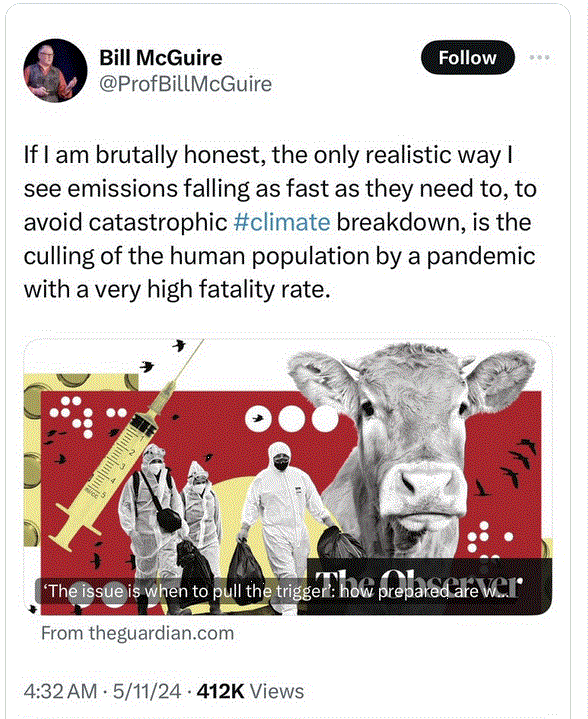 Thirty years of telling us that humans are bad has consequences. As Elon Musk said” They want a holocaust for humanity.” It turns out a televised diet of one-sided climate projection by mendicant B-Grade witchdoctors might be a dangerous thing for mental health. If only Bill McQuire had seen a skeptic on TV? Thirty years of telling us that humans are bad has consequences. As Elon Musk said” They want a holocaust for humanity.” It turns out a televised diet of one-sided climate projection by mendicant B-Grade witchdoctors might be a dangerous thing for mental health. If only Bill McQuire had seen a skeptic on TV?
Predictably the McGuire tweet spread far, and got crushing replies so the Emeritus Professor deleted it, as all cowards do, yelling at us:

To which the winning reply was:
McGuire kept digging, declaring that “ I DID NOT SAY ‘WE NEED A PANDEMIC..’” only of course, he did say we need emissions reduction and that a pandemic was the only realistic way to do that. He told us he was being brutally honest after all. “I COULD HAVE SAID SOCIETY-BUSTING ASTEROID IMPACT INSTEAD OF PANDEMIC” he lamented, like that was so much better.
So spread the word, academia has become a cult. Don’t let children go there unprotected.
Remember once a mind is infected with Climate Change, bioweapons are just another kind of carbon credit.
The problem is not the Climate Cult itself, it’s the censorship that feeds the sickness…
h/t Old Ozzie, Another Ian, El Gordo
9.8 out of 10 based on 107 ratings
9.5 out of 10 based on 23 ratings
By Jo Nova
The glut in solar power in Australia is so big that next year solar panel owners in Sydney will have to pay 1.2c a kilowatt hour to offload their unwanted energy between 10am and 3pm. Nearly a million homes in Sydney have solar panels, but only 7% of them have batteries, which means basically, thousands of homes installed hi-tech generators that aren’t very useful. Worse, other homes were forced to pay part of the costs for them. The only winner was China.
Finally, a tiny part of the strangled free market is re-asserting itself, which might slow down future installations, or trick a few people into installing a $9,000 battery. Naturally this unpredictable rule change will hurt the poorest solar owners, but benefit those wealthy enough to afford a battery.
by Caitlin Fitzsimmons, Sydney Morning Herald
The biggest electricity distributor on the east coast plans to charge households with solar panels to export their electricity to the grid during the middle of the day.
Ausgrid will impose a penalty of 1.2¢ a kilowatt-hour for any electricity exported to the grid between 10am and 3pm above a free threshold that varies by month. During peak demand times, between 4pm and 9pm, Ausgrid would pay 2.3¢ an hour as a reward to customers exporting solar to the grid.
The tariff will be charged by Ausgrid and the retailer will decide how to package it. It is opt-in from July this year, and mandatory from July next year.
The Sydney Morning Herald naturally thinks this is backwards and unfair, and in a sense it is, homeowners were led up the garden path. No one was given realistic information before they purchased another useless panel. But where was The Sydney Morning Herald? — it was selling the garden path. If they interviewed a few skeptics they could have told the hapless homeowners that the forced transition was artificial, unmanageable, and the conditions were doomed to be “adjusted” sooner or later.
Solar power at noon is electrical sewage
The wholesale market was trying to send the message. Negative spot prices show that solar is essentially a waste product at lunchtime which needs to be disposed off, a bit like electrical sewage.
Negative spot revenues didn’t really occur until we installed the last two million solar panels that we didn’t need. It is obviously a growing problem now, which suspiciously peaks in spring and summer and falls in winter months –matching the solar output profile by month.
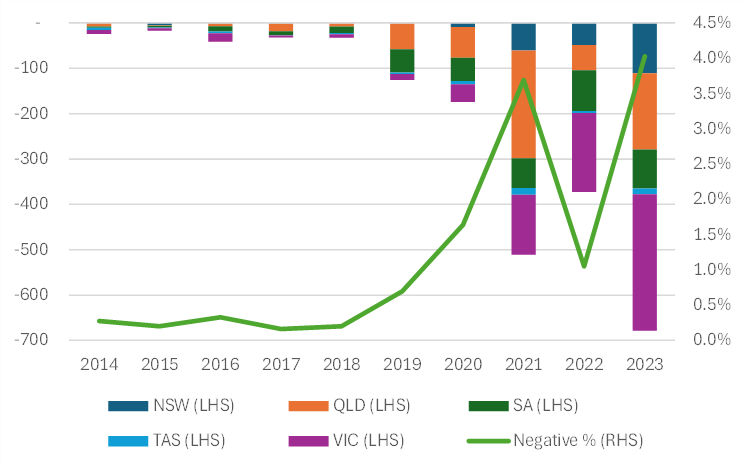 https://www.energycouncil.com.au/analysis/negative-prices-and-revenues-in-the-nem-over-the-past-decade/ You might wonder why any generator would keep generating during a glut so bad they had to pay for every watt they generated. But it’s logical in a screwed market — the negative prices are close to the value of the “Renewable Energy Certificates” the government forces us all to pay to solar and wind operators. So solar owners can produce a product the market essentially doesn’t want, but the government forces us to pay to make it profitable. See how this works?
The point of a free market is that stupid ideas are supposed to be free to lose their own money. That’s a signal to stop doing it.
And if there was some use for solar power at midday, negative prices would have found it. If there was an AI supercomputer that needed to sleep 18 hours a day and only work at lunchtime, the owners would have been beating down the door to get paid to use that solar juice. It didn’t happen.
Here’s the solar power contribution to the NSW grid this month.
 https://anero.id/energy/2024/may
During the solar spikes, hundreds of tons of exquisitely tuned infrastructure that could have kept running, just sits around and waits in case a cloud rolls over. And efficiency gained by solar is lost by the rest of the system.
h/t David of Cooyal in Oz
9.9 out of 10 based on 101 ratings
10 out of 10 based on 11 ratings
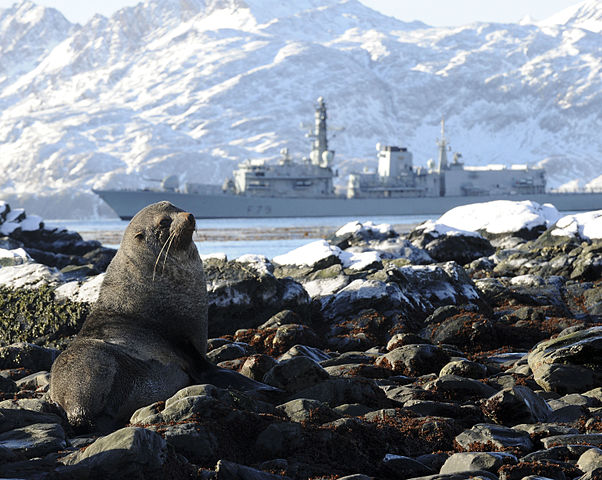
While no one was paying attention, a Russian ship exploring Antarctica claims it has found oil and gas deposits that are ten times larger than the North Sea. Presumably quite a lot of countries would find this very interesting. At the moment Antarctica is supposedly protected by a piece of paper, but those who want to keep something so valuable to themselves will be needing more than cellulose.
It could take some fossil fuels to protect these fossil fuels
Hard to see any nation keeping control of this oil and gas field using sailing boats, solar powered ships and missiles running on palm oil.
Johnathon Leake, Telegraph
Russia has found vast oil and gas reserves in the Antarctic, much of it in areas claimed by the UK.
The surveys are a prelude to bringing in drilling rigs to exploit the pristine region for fossil fuels, MPs have warned.
Reserves totalling 511bn barrels of oil – about 10 times the North Sea’s entire 50-year output – have been reported to Moscow by Russian research ships, according to evidence given to the Commons Environment Audit Committee (EAC) last week.
It follows a series of surveys by the Alexander Karpinsky vessel, operated by Rosgeo – the Russian agency charged with finding mineral reserves for commercial exploitation.
The total extracted from the North sea up until 2014 was about 42 billion barrels of “oil equivalent”. Green fanatics would be horrified to think of all the emissions that might be unleashed, but 3 billion cold people in China, Russia, India and Japan might have a different view.
It’s hard to believe no one has staked a claim on Marie Byrd Land. We’re they just too busy to attend the meeting?
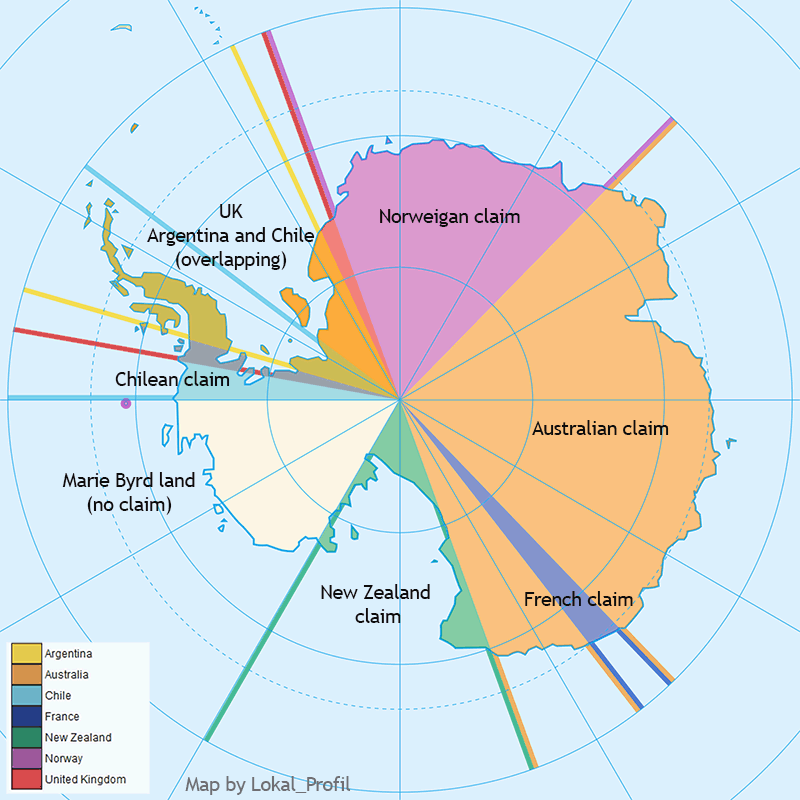
Russia claims that its boat was just doing scientific research (just like those Japanese whalers were).
At least a part of the UK government apparently found out about this when a South African newspaper published a story on it. (Who needs intelligence when you can read the Daily Maverick?)
The EAC [Environment Audit Committee] decided to challenge the Foreign Office’s management of the UK’s Antarctic interests following reports in the Daily Maverick, a South African online journal, which discovered Moscow’s activities after its survey ship docked in Cape Town.
The British government has officially said they believe the Russians, but a few in the British government are skeptical. (From the Daily Maverick)
[Anna McMorrin, a Labour MP on the polar audit sub-committee] asked FCDO Under-Secretary David Rutley… if he was “aware” of the Rosgeo vessels, under US sanctions since February, and how the UK was to respond at the annual Antarctic Treaty consultative meeting (ATCM) in India from May 20 to 30.
The under-secretary defended Russia’s “repeated assurances” at ATCMs “that these activities are for scientific purposes”.
A sceptical McMorrin asked Rutley if he was “content to believe Russia when they say they’re just undertaking scientific action”. The Labour MP also quoted expert testimony to the committee, stressing that leading polar geopolitician Professor Klaus Dodds had flagged the “current Russian activity” and its possible “prospecting” links as “troubling”.
“There is a worry that Russia is collecting seismic data that could be construed to be prospecting rather than scientific research. And, if such, does this signal a potential threat to the permanent ban on mining,” asked Dodds, of Royal Holloway, University of London, “with knock-on implications for the integrity of the protocol in its entirety?”
Suddenly people might start paying attention to Antarctica.
hat tip to @TomNelson and @NetZeroWatch
______________________________________
For the record, the dispute between the UK and Argentina goes back a long way.
Photo: LA(Phot) Ian Simpson of the HMS Portland in South Georgia in 2010 on Wikimedia
10 out of 10 based on 83 ratings
9.2 out of 10 based on 13 ratings
|
JoNova A science presenter, writer, speaker & former TV host; author of The Skeptic's Handbook (over 200,000 copies distributed & available in 15 languages).

Jo appreciates your support to help her keep doing what she does. This blog is funded by donations. Thanks!


 Follow Jo's Tweets
Follow Jo's Tweets To report "lost" comments or defamatory and offensive remarks, email the moderators at: support.jonova AT proton.me
Statistics
The nerds have the numbers on precious metals investments on the ASX
|
 It [the Wiley debacle] also illustrates what is just another front in a much broader crisis of trust confronting universities and scientific institutions worldwide.
It [the Wiley debacle] also illustrates what is just another front in a much broader crisis of trust confronting universities and scientific institutions worldwide.



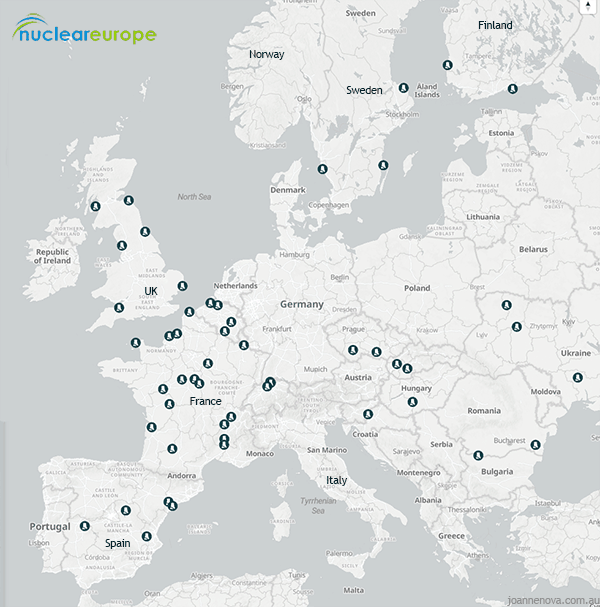
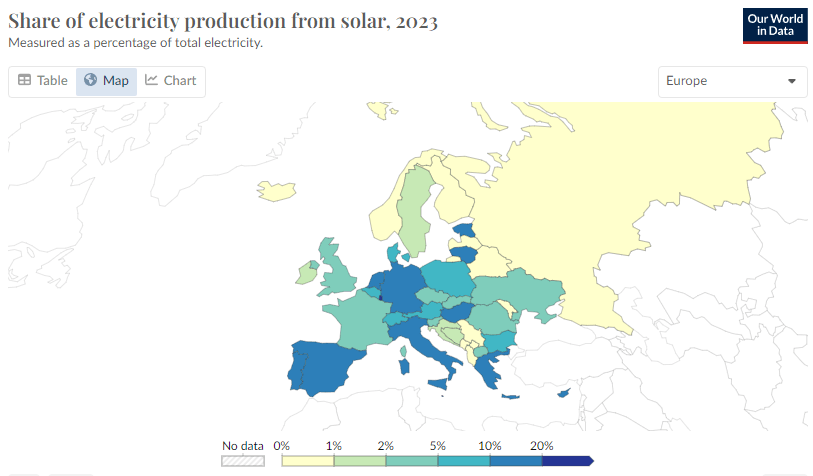
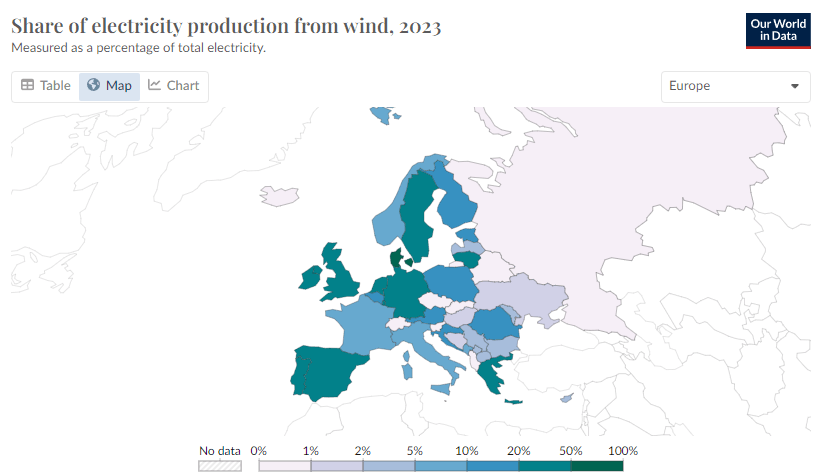



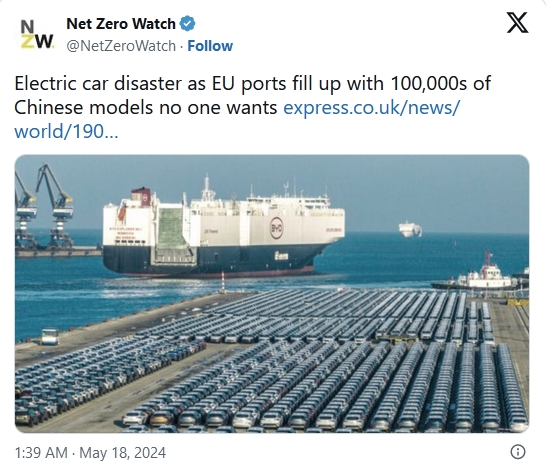
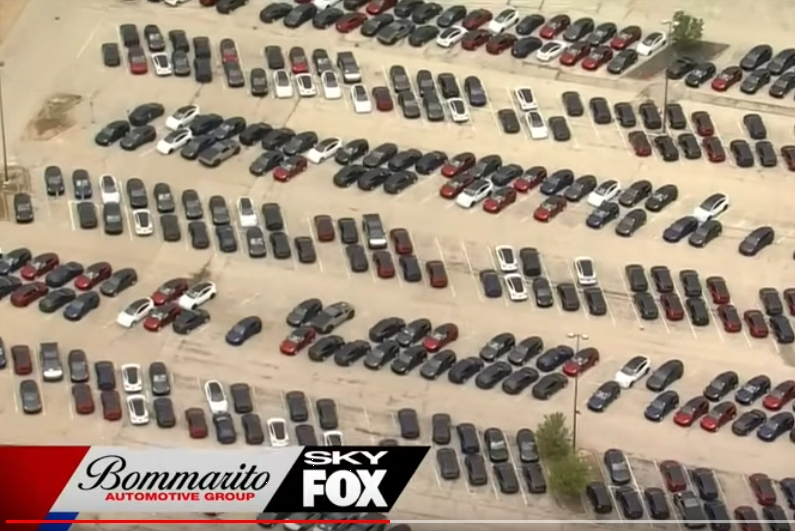



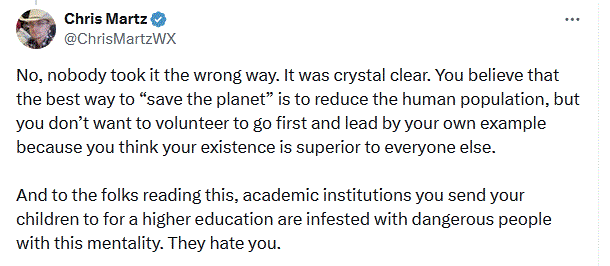















Recent Comments